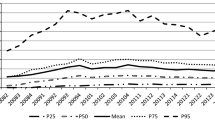Abstract
With new regulations like the credit valuation adjustment, the assessment of wrong-way-risk is of utter importance. We analyse the effect of a counterparty’s credit risk and its influence on other asset classes (equity, currency, commodity and interest rate) in the event of extreme market movements like the counterparty’s default. With an extreme value approach, we model the tail of the joint distribution of different asset returns belonging to the above asset classes and counterparty credit risk indicated by changes in CDS spreads and calculate the effect on the expected shortfall when conditioning on counterparty credit risk. We find the conditional expected shortfall to be 2 to 440% higher than the unconditional expected shortfall depending on the asset class. Our results give insights both for risk management and for setting an initial margin for non-centrally cleared derivatives which becomes mandatory in the European Market Infrastructure Regulation.





Similar content being viewed by others
Notes
Yield curve spot rate, 10-year maturity - Government bond, nominal, all issuers all ratings included-Euro area (changing composition).
Market yield on U.S. Treasury securities at constant maturity, quoted on investment basis.
References
Alter, A., and Y.S. Schüler. 2012. Credit spread interdependencies of European states and banks during the financial crisis. Journal of Banking and Finance 36(12): 3444–3468.
Basle Committee on Banking Supervision (2015). Margin requirements for non-centrally cleared derivatives.
Baur, D.G., and T.K. McDermott. 2010. Is gold a safe haven? international evidence. Journal of Banking and Finance 34(8): 1886–1898.
Glasserman, P. and Yang, L. (2015). Bounding wrong-way risk in measuring counterparty risk. Office of Financial Research Working Paper, (15-16).
Gumbel, E. (1961). Multivariate extremal distributions. In Bulletin de l’Institut International de Statistiques, number Session 33, Book 2, Paris.
Hofer, M. 2016. Path-consistent wrong-way risk: A structural model approach. Journal of Risk 19(1):
Hull, J., and A. White. 2012. Cva and wrong-way risk. Financial Analysts Journal 68(5): 58–69.
Kenyon, C. and Green, A. D. (2016). Option-based pricing of wrong way risk for cva. Available at SSRN 2814613.
Longin, F., and B. Solnik. 2001. Extreme correlation of international equity markets. Journal of Finance 56(2): 649–676.
McNeil, A.J., and R. Frey. 2000. Estimation of tail-related risk measures for heteroscedastic financial time series: an extreme value approach. Journal of Empirical Finance 7(3): 271–300.
Rosen, D., and D. Saunders. 2012. Cva the wrong way. Journal of Risk Management in Financial Institutions 5(3): 252–272.
Tiago de Oliveira, J. 1973. Statistical extremes-a survey. Lisbon: Center of Applied Mathematics.
Yamai, Y., and T. Yoshiba. 2005. Value-at-risk versus expected shortfall: A practical perspective. Journal of Banking and Finance 29(4): 997–1015.
Author information
Authors and Affiliations
Corresponding author
Rights and permissions
About this article
Cite this article
Müller, J., Posch, P.N. Wrong-way-risk in tails. J Asset Manag 19, 205–215 (2018). https://doi.org/10.1057/s41260-018-0076-9
Published:
Issue Date:
DOI: https://doi.org/10.1057/s41260-018-0076-9




